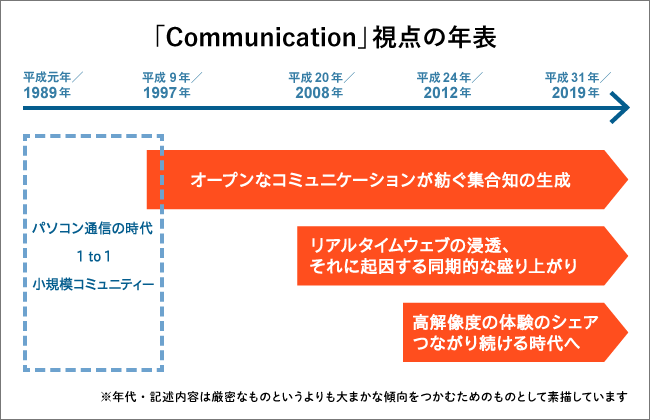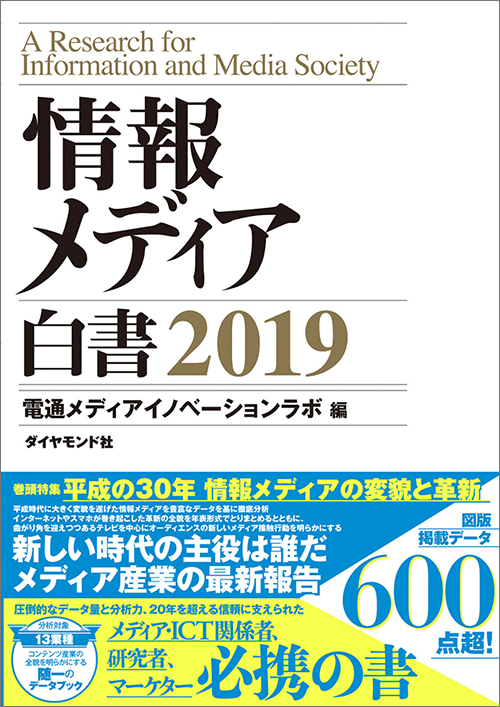Dentsu Inc. Media Innovation Lab published the "Information Media White Paper 2019" (Diamond Inc.) in February.
The opening feature, titled "30 Years of Heisei: The Transformation and Innovation of Information Media," looks back on the evolution of media up to the present, examining both user trends and business developments.
Parts 3 through 5 of this series will attempt to revisit the chronology we compiled for the white paper, using the three Cs defining information behavior—Communication, Content, and Context—as keywords. This is to consider what value (i.e., richness) information media has brought to our society throughout the 30 years of the Heisei era.
This installment focuses on "Communication," with the rise and evolution of social media—which connects people and creates "spaces"—as its main theme. We aim to outline how changes in our communication practices have influenced Japan's media environment.
It's important to note that these three Cs are not independent and isolated; over the past 30 years, their interrelationships have grown increasingly strong. This time, let's dive into the sea of events that is the timeline, focusing on how communication has influenced content and context.
The "CPT" mentioned in the title stands for Communication Per Time. As a keyword for deciphering the social communication environment of the post-Heisei (i.e., Reiwa) era, it will be explained in section ④, which covers the latest trends.
① The Birth of Open Spaces and Collective Intelligence Woven Through Communication
For those of us living in 2019, social media has become an indispensable part of our daily lives. This is confirmed by numerous survey results we have published. In fact, many of you likely found this article through shares on social media.
However, the notion that social media alone made us connect tends to lean toward technological determinism. Let's examine fragments from our timeline showing that we have always had an inclination toward communication and, through it, toward connection—toward the social.
● Heisei 9 / 1997: Amezou Link launched (first thread-floating bulletin board)
● Heisei 11 / 1999: 2channel launched From PC communications to the Internet. This shift occurring during the Heisei era moved many people into an environment where communication was possible, and gradually took on a stronger 1 to N character, moving away from 1 to 1.
The "bulletin boards" that emerged in the late 90s. Particularly the thread-floating bulletin boards※ highlighted here created spaces where users could openly communicate around specific themes. While bulletin board functions existed on personal homepages before, this period marked the birth of a new practice: users gathering in one large space to exchange information through communication. A place where information accumulated, generating "public opinion" and "trends," was born.
Another defining feature of this era was the email newsletter, a medium that also opened up our communication. It fostered a culture where individuals could share their expertise and messages with an undefined audience. Recalling that the service's core philosophy was to turn readers into writers, we can acknowledge the fact that the interchangeability between readers and writers—in other words, its N to N nature—became embedded within society.
●2004: The Huge Hit "Train Man" " Train Man," which gained immense popularity on a 2channel (now 5channel) thread, was turned into a book and later adapted into a drama (currently in production as the Hollywood drama "Train Man"), becoming a social phenomenon. This was the most cutting-edge and distinctly Japanese example of collective intelligence acting creatively—in other words, communication being sublimated into content through a bottom-up process.
●2009: Launch of services aggregating online user-generated content like Naver Matome and Togetter. Collective intelligence-based information curation, exemplified by Wikipedia, accelerated from the late 2000s. There was a growing demand for collective intelligence that compiled trending information and useful life tips. This led to the rise of so-called "summary sites" that aggregated and republished content shared by users on social media as articles. Curation media, which became commonplace in the 2010s, also fits within this trend.
※Thread-floating bulletin board: A type of bulletin board where threads move to the top (float) when new posts are made, effectively boosting and visualizing threads with active communication.   nbsp;
②The penetration of real-time web and the resulting synchronous excitement
SNS is indispensable when considering communication in the Heisei era. The year 2008 marked a turning point, as both of these platforms—which have a particularly large user base in Japan—launched Japanese versions.
● Heisei 20 / 2008: Japanese versions of Twitter and Facebook launched Facebook, of course, but Twitter in particular brought real-time web communication, promoting the spread of "synchronous connections" where people communicate about what's happening right now, at the same time.
The following case study highlighted this approach.
●2013: "Bals!" during the broadcast of "Castle in the Sky" sets a new world record for tweets per second on Twitter. The nationwide joy of tweeting "Bals!" can be explained by the excitement generated by this synchronous connection. While content typically offers higher utility upon first exposure, this case proved that those who knew when "Bals!" would appear experienced greater catharsis. The enjoyment came precisely because the outcome was known.
Furthermore, the fact that this reached the level of a social "festival" underscores its significance in media communication history. The compelling pull of this synchrony, which even drew in people who hadn't planned to watch, signifies the close bond between communication and content.
This practice of "communicating and getting excited while watching a video" can be said to have emerged within the context of Japanese internet culture around this time.
●2006: Launch of the NicoNico Douga Service
Within Niconico Douga, the practice of everyone getting excited together while watching bullet-hell videos (where the playback screen is completely covered) is nothing other than the synchrony mentioned earlier. The spread of this practice of getting excited not just through the video content itself, but through the communication happening there, greatly advanced the possibilities of content viewing.
③ The Rise of Shared Experiences Through Visual Sharing, and the Era of Continuous Connection
Today, sharing via social media from smartphones has become commonplace, and we increasingly convey our daily experiences with higher resolution through visuals like photos and videos. Dentsu Inc. has published numerous analytical articles on this trend in visual communication.
When discussing the media landscape of the Heisei era, where watching and creating videos became part of daily life, YouTube must be mentioned first.
● Heisei 17 / 2005: YouTube founded (US)
● Heisei 18 / 2006: Google acquires YouTube By the close of the Heisei era, YouTube had grown into an overwhelming platform not only in Japan but globally. It became indispensable for consumers, businesses, and brands alike—serving as a venue for videos by brands and publishers, and as a platform leveraged by influencers known as YouTubers.
The counterpart to this visual communication revolution was the launch of Instagram, which popularized photo-sharing and spawned buzzwords like "Instagrammable."
●Heisei 24 / 2012: Instagram Launches
●Heisei 30 / 2018: Instagram Surpasses Facebook in Japan's MAU (Monthly Active Users) Last year's official announcement that Instagram had overtaken Facebook in MAU within Japan was striking. It underscores the momentum in the visual communication space.
Originally a place to share photos capturing special experiences and extraordinary moments in an appealing, stylish way, Instagram is rapidly transforming. This is driven by the integration of ephemeral formats like Stories (where posts automatically disappear after a set time), live streaming, and IGTV (a dedicated video app) for vertical videos up to 60 minutes. These developments can be seen as an evolution that enhances the resolution of experience sharing.
●2017: Launch of TikTok Japan Numerous other services enabling innovative experience sharing have also emerged. TikTok, which allows users to easily share creative 15-second videos, continues to grow its user base, particularly among younger demographics, raising expectations for new forms of communication.
●2015: LINE LIVE service launched From another perspective, another major trend emerges: the need to track the movement toward "connecting live," or synchronous communication. LINE LIVE, one of the representative services, became a platform where many people, from ordinary users to influencers, could connect themselves and others through synchronous communication channels.
●2018: Rise of VTubers; Mirrativ, a smartphone-exclusive game streaming app, launches avatar service
As a topic also covered in the 2019 Information Media White Paper, the connections facilitated through VTubers—avatars (virtual personas)—highlight distinctly Japanese cultural elements. Meanwhile, Mirrativ's service enabling live streaming (primarily game commentary) using avatars is brimming with foresight, hinting at the future of how we connect.
④ "CPT": Decoding Post-Heisei Social Communication
In the era of the new 5G communication standard, which is expected to see increased adoption, we should see a shift not just toward "connecting," but toward "staying connected."
In this era of continuous connection, following the concept of Information Per Time (IPT) – meaning information volume per unit time – we will likely see the emergence of Communication Per Time (CPT), meaning communication volume per unit time.
Just as livestreamers and their audiences constantly interact, or users connect and occasionally converse with each other, or people enjoy watching game commentary while communicating—the idea is that users will increasingly demand Communication Per Time (CPT) as the measure that guarantees the richness and excitement of that time.
The essence of communication through social media, deeply rooted in our daily lives as we live through the closing years of the Heisei era, lies in its uncertainty: information reaching unintended recipients, and unintended elements becoming part of the communication. This very uncertainty accelerates the spread of information.
However, looking back, communication has always inherently contained the possibility of error—not just the clear act of "delivering a message to the intended recipient," but also the failure of intended messages to reach their target and the unintended transmission of things never meant to be communicated.
The Heisei era was precisely when this fundamental nature of communication became visible and exposed. This chain reaction then gave rise to phenomena like the emergence of new content, the continuous weaving of context as information is refined into data... ultimately leading to the interconnection of the three Cs mentioned at the outset.
The 'Information Media White Paper 2019' includes the complete version of the timeline that could not be presented in this article due to space constraints. We sincerely hope you will obtain a copy and review it.





